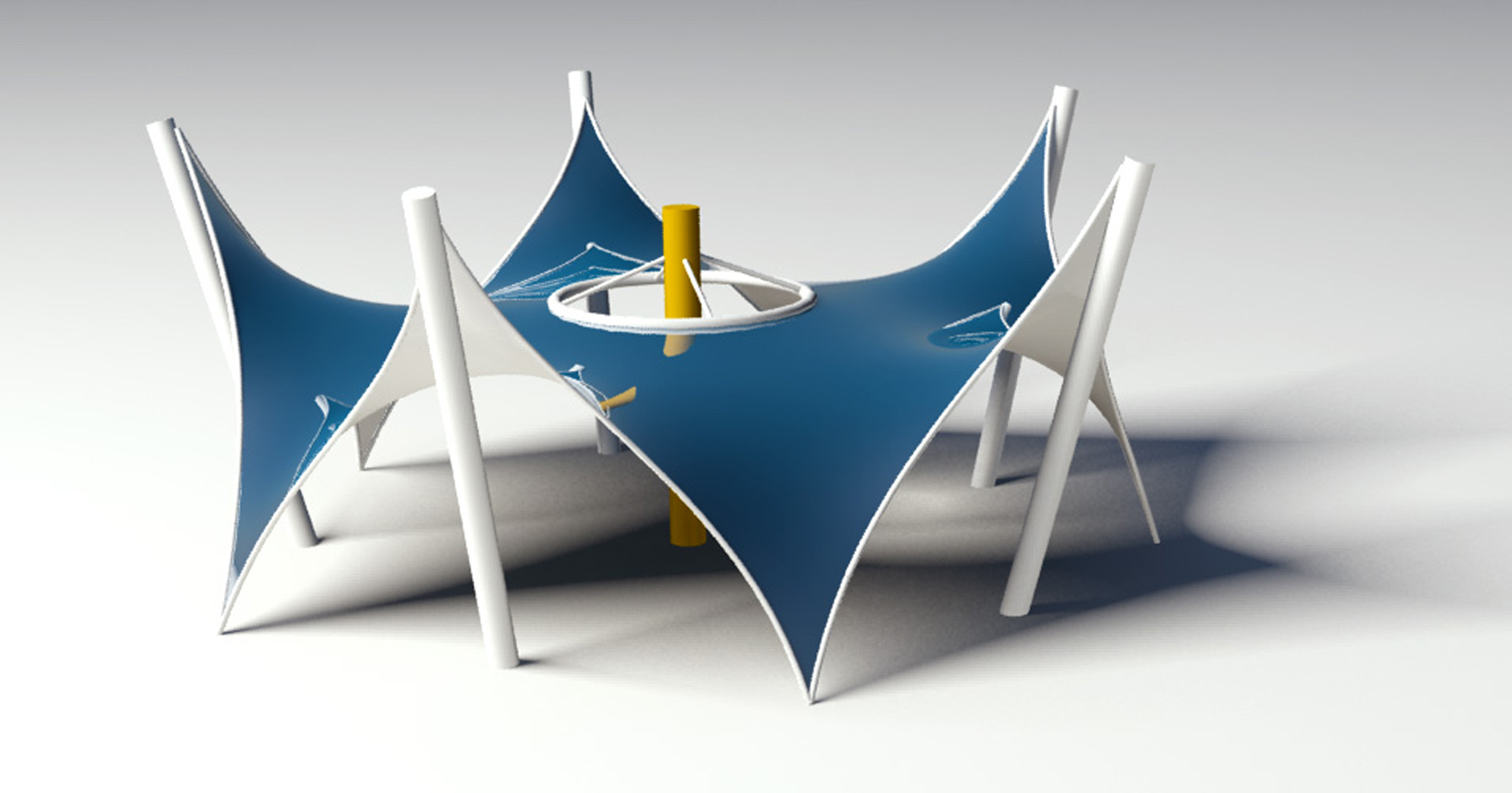“Robust modeling of constant mean curvature surfaces” by Pan, Choi, Liu, Hu, Du, et al. …
Conference:
Type(s):
Title:
- Robust modeling of constant mean curvature surfaces
Presenter(s)/Author(s):
Abstract:
We present a new method for modeling discrete constant mean curvature (CMC) surfaces, which arise frequently in nature and are highly demanded in architecture and other engineering applications. Our method is based on a novel use of the CVT (centroidal Voronoi tessellation) optimization framework. We devise a CVT-CMC energy function defined as a combination of an extended CVT energy and a volume functional. We show that minimizing the CVT-CMC energy is asymptotically equivalent to minimizing mesh surface area with a fixed volume, thus defining a discrete CMC surface. The CVT term in the energy function ensures high mesh quality throughout the evolution of a CMC surface in an interactive design process for form finding. Our method is capable of modeling CMC surfaces with fixed or free boundaries and is robust with respect to input mesh quality and topology changes. Experiments show that the new method generates discrete CMC surfaces of improved mesh quality over existing methods.
References:
1. Bobenko, A. I., and Springborn, B. A. 2007. A discrete Laplace-Beltrami operator for simplicial surfaces. Discrete & Computational Geometry 38, 4, 740–756. Google ScholarDigital Library
2. Brakke, K. 1992. The Surface Evolver. Experimental Mathematics 1, 2, 141–165.Google ScholarCross Ref
3. Brakke, K., 2012. The Surface Evolver, version 2.30. http://www.susqu.edu/brakke/evolver/evolver.html, May.Google Scholar
4. Brew, J., and Lewis, W. 2003. Computational form-finding of tension membrane structures — Non-finite element approaches: Part 1. Use of cubic splines in finding minimal surface membranes. International journal for numerical methods in engineering 56, 5, 651–668.Google Scholar
5. Brew, J., and Lewis, W. 2003. Computational form-finding of tension membrane structures — Non-finite element approaches: Part 2. Triangular mesh discretization and control of mesh distortion in modelling minimal surface membranes. International Journal for Numerical Methods in Engineering 56, 5, 669–684.Google ScholarCross Ref
6. Chopp, D. 1993. Computing minimal surfaces via level set curvature flow. Journal of Computational Physics 106, 77–77. Google ScholarDigital Library
7. Du, Q., Faber, V., and Gunzburger, M. 1999. Centroidal Voronoi tessellations: Applications and algorithms. SIAM Review 41, 4, 637–676. Google ScholarDigital Library
8. Du, Q., Gunzburger, M., and Ju, L. 2003. Constrained centroidal Voronoi tessellations for surfaces. SIAM Journal on Scientific Computing 24, 5, 1488–1506. Google ScholarDigital Library
9. Du, Q., Gunzburger, M., and Ju, L. 2010. Advances in studies and applications of centroidal Voronoi tessellations. Numer. Math. Theor. Meth. Appl. 3, 119–142.Google ScholarCross Ref
10. Dyer, R., Zhang, H., and Möller, T. 2007. Delaunay mesh construction. In Proceedings of the fifth Eurographics Symposium on Geometry Processing, Eurographics Association, Aire-la-Ville, Switzerland, 273–282. Google ScholarDigital Library
11. Dziuk, G., and Hutchinson, J. E. 2006. Finite element approximations to surfaces of prescribed variable mean curvature. Numerische Mathematik 102, 611–648. 10.1007/s00211-005-0649-7.Google ScholarDigital Library
12. Gersho, A. 1979. Asymptotically optimal block quantization. IEEE Transactions on Information Theory 25, 4, 373–380. Google ScholarDigital Library
13. Goldstein, R., Moffatt, H., Pesci, A., and Ricca, R. 2010. Soap-film Möbius strip changes topology with a twist singularity. Proceedings of the National Academy of Sciences 107, 51, 21979.Google ScholarCross Ref
14. Gruber, P. 2001. Optimal configurations of finite sets in Riemannian 2-manifolds. Geometriae Dedicata 84, 271–320. 10.1023/A:1010358407868.Google ScholarCross Ref
15. Hadzhilazova, M., Mladenov, I., and Oprea, J. 2007. Unduloids and their geometry. Archivum Mathematicum 43, 5, 417–429.Google Scholar
16. Kapouleas, N. 1990. Complete constant mean curvature surfaces in Euclidean three-space. The Annals of Mathematics 131, 2, 239–330.Google ScholarCross Ref
17. Liu, D., and Nocedal, J. 1989. On the limited memory bfgs method for large scale optimization. Mathematical programming 45, 1, 503–528. Google ScholarDigital Library
18. Liu, Y., Wang, W., Lévy, B., Sun, F., Yan, D.-M., Lu, L., and Yang, C. 2009. On centroidal Voronoi tessellation—energy smoothness and fast computation. ACM Trans. Graph. 28, 4, 1–17. Google ScholarDigital Library
19. Meyer, M., Desbrun, M., Schröder, P., and Barr, A. H. 2003. Discrete differential-geometry operators for triangulated 2-manifolds. In Visualization and Mathematics III, H.-C. Hege and K. Polthier, Eds. Springer-Verlag, Heidelberg, 35–57.Google Scholar
20. Oberknapp, B., and Polthier, K. 1997. An algorithm for discrete constant mean curvature surfaces. In Visualization and Mathematics, H.-C. Hege and K. Polthier, Eds. Springer Verlag, Heidelberg, 141–161. Google ScholarDigital Library
21. Osserman, R. 2002. A survey of minimal surfaces. Dover Pubns.Google Scholar
22. Pardalos, P., and Romeijn, H. 2002. Handbook of global optimization. Volume 2. Kluwer.Google Scholar
23. Pinkall, U., and Polthier, K. 1993. Computing discrete minimal surfaces and their conjugates. Experimental mathematics 2, 1, 15–36.Google Scholar
24. Polthier, K., and Rossman, W. 2002. Discrete constant mean curvature surfaces and their index. J. reine angew. Math., 549, 47–77.Google Scholar
25. Smith, J. 2003. Three Applications of Optimization in Computer Graphics. PhD thesis, Robotics Institute, Carnegie Mellon University, Pittsburgh, PA. Google ScholarDigital Library
26. Taylor, J. E. 1976. The structure of singularities in soap-bubble-like and soap-film-like minimal surfaces. The Annals of Mathematics 103, 3, 489–539.Google ScholarCross Ref
27. Xu, G., and Zhang, Q. 2008. A general framework for surface modeling using geometric partial differential equations. Computer Aided Geometric Design 25, 3, 181–202. Google ScholarDigital Library
28. Xu, G., Pan, Q., and Bajaj, C. 2006. Discrete surface modelling using partial differential equations. Computer Aided Geometric Design 23, 2, 125–145. Google ScholarDigital Library
29. Yan, D., Lévy, B., Liu, Y., Sun, F., and Wang, W. 2009. Isotropic remeshing with fast and exact computation of restricted Voronoi diagram. In Computer graphics forum, vol. 28, Wiley Online Library, 1445–1454. Google ScholarDigital Library
30. Yan, D., Wang, W., Lévy, B., and Liu, Y. 2010. Efficient computation of 3D clipped Voronoi diagram. Advances in Geometric Modeling and Processing, 269–282. Google ScholarDigital Library




